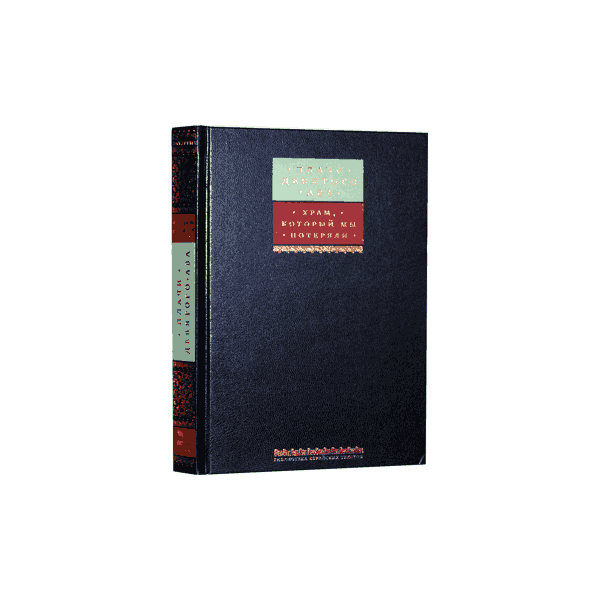Kinot. Cry of 9 Ava
The book contains the book of Eiha; Kinot (mourning ellegia) which read the Ninth Ava; laws and customs of the Ninth Ava and three weeks previous it; a sketch describing the device of the Jerusalem Temple, history of its construction and destruction.
From the translation editor
The book "Kinot", "laments the Ninth of Av" was first published in two parallel editions: in Krakow (1585) and Venice (1590), respectively, in the Ashkenazi and Sephardi traditions. Since then it has been republished many times and still read every year by the due date in all Jewish communities in the world.
Textual differences in the different editions of this book are numerous enough, but remains unchanged nationwide awareness of guilt, repentance, a sense of deep sadness about the destruction of the Holy Temple in Jerusalem and the belief in its future revival.
For the first time carrying a Russian translation of the book "laments the Ninth of Av," the authors transfers benefit from the most complete and verified academic edition, published by the publishing house "Mossad ha-Rav Kook" (1968, Jerusalem).
The original text and the main prayer, which, according to ancient custom, the Jews read on the day of Tisha B'Av is the book "Lamentation," which in Russian cultural and religious tradition called "Lamentations." Although the text of the Tanakh name of the creator of this book is not given, the Babylonian Talmud ("Bava Batra", 15a) actually calls it the author of the great prophet Irmeyagu.
Five hundred years ago, an unknown compiler of the book "Kinot" Getting to his work, stood in front of a difficult but truly creative challenge: many of Kinot mournful prayers and songs created by the Jewish people for many centuries, to select and highlight those that would be most clearly concentrated and meaning, and the whole bottomless depth of national grief.
Forty-six poems, laments, selected for this purpose and located in a specific sequence compiler, became flesh and unusual themes of the book "Kinot." The texts of these poems created by different authors over several centuries in the Middle Ages and early Renaissance, but thematically they all relate to the biblical book of "Lamentations" and its varied motives.
The era of the early Renaissance in Europe was marked in European poetry, in particular, the widespread use of rhyme and yambohoreicheskoy foot. It has become a characteristic feature of the development of European poetry for the next millennium. But the era of the Renaissance, by definition, marked the return of the Europeans to the ideals of antiquity and its stylistic sources in art. Accordingly, the beginnings of yambohoreicheskogo verse and rhyme Europeans found in the poetry of the ancient Greeks.
Hebrew poetry of the time, incarnate brilliant galaxy of writers, too, experienced a kind of renaissance and, in particular, is also distinguished phenomenon unchanged rhymes and yambohoreicheskoy foot. But their ideals and stylistic sources of Hebrew poetry sought and successfully found in the Tanakh: first of all in the Psalms and in the "Song of Songs" in addition to the traditional prayers, and especially in the book of "Lamentations." A striking example of the first cry, intonation, set the tone for the book, "laments the Ninth of Av," which mainly consists of lines of the ancient text of the book "Lamentation", but represents a completely full rhyme, stylistically wholly owned his age.
Based on this understanding of the deep poetic essence of the book "Lamentation" and especially for this edition was made of her new translation, the style is largely determined and implemented for the first time the Russian translations of various texts that are included in this book. These 46 poems belong sometimes anonymous, sometimes famous and well-known authors, but in all cases the translators have sought to implement his plan, with responsibility and creative excitement, guided by wise counsel of our teachers Rambam from his "Epistle Shmuel ibn Tibon" in 1199: "He who wants to do translations and intends to translate each word literally, slavishly eleduya order of words and sentences in the original, will not succeed in his work, and his translation is false and false ... Decent translator must not reproduce the order of words and sentences, and the exercise of their common sense. "
This is the lesson of Rambam most applicable to the poetic song and prayer texts, where a translator is obliged to identify not only the "common sense", but also the mood, rhythm and melody of the poetic word. As far as the translators failed to fulfill its task, let the readers judge that on the day of Tisha B'Av will open the book in the synagogue to read it from the first page to the last.
God will hear our prayers and let come true prophet foretold His revival of the Holy Temple was soon in our days!
| Shelf | Barrie |
|---|---|
| Weight | 0.540000 |
| Publisher | Lechaim |
| ISBN | 978 5 900309 46 0 |
| Height (CM) | 22 |
| Length (CM) | 16 |

 Russian
Russian


